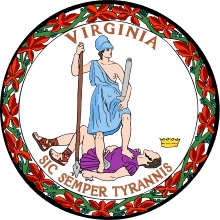John Smith (explorer)
| John Smith | |
|---|---|
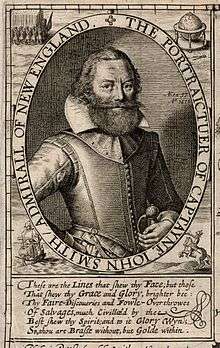 Captain John Smith (1624) | |
| Born | Lincolnshire, England |
| Baptised | 6 January 1580 |
| Died |
21 June 1631 (aged 51) London, England |
| Resting place | St Sepulchre-without-Newgate, London |
| Known for | Helping to establish and govern the Jamestown colony |
John Smith (baptized. 6 January 1580 – 21 June 1631) was an English soldier, explorer, colonial governor, Admiral of New England, and author. He played an important role in the establishment of the Jamestown colony, the first permanent English settlement in North America, in the early 17th century. Smith was a leader of the Virginia Colony based at Jamestown between September 1608 and August 1609, and led an exploration along the rivers of Virginia and the Chesapeake Bay, during which he became the first English explorer to map the Chesapeake Bay area. Later, he explored and mapped the coast of New England. He was knighted for his services to Sigismund Báthory, Prince of Transylvania, and his friend Mózes Székely.
When Jamestown was established in 1607, Smith trained the first settlers to farm and work, thus saving the colony from early devastation. He publicly stated "He that will not work, shall not eat", equivalent to the 2nd Thessalonians 3:10 in the Bible.[1] Harsh weather, lack of food and water, the surrounding swampy wilderness, and attacks from local Indians almost destroyed the colony. With Smith's leadership, however, Jamestown survived and eventually flourished. Smith was forced to return to England after being injured by an accidental explosion of gunpowder in a canoe.
Smith's books and maps were important in encouraging and supporting English colonization of the New World. He gave the name New England to the region that is now the Northeastern United States and noted: "Here every man may be master and owner of his owne labour and land... If he have nothing but his hands, he may...by industries quickly grow rich."[2] Smith died in London in 1631.
Early adventures
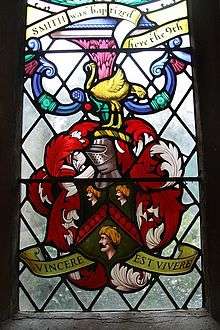
John Smith was baptized on 6 January 1580 at Willoughby,[3] near Alford, Lincolnshire, where his parents rented a farm from Lord Willoughby. He claimed descent from the ancient Smith family of Cuerdley, Lancashire,[4] and was educated at King Edward VI Grammar School, Louth from 1592 to 1595.[5]
After his father died, Smith left home at the age of sixteen and set off to sea. He served as a mercenary in the army of Henry IV of France against the Spaniards, fighting for Dutch independence from King Philip II of Spain. He then set off for the Mediterranean. There he engaged in both trade and piracy, and later fought against the Ottoman Turks in the Long Turkish War. Smith was promoted to a cavalry captain while fighting for the Austrian Habsburgs in Hungary in the campaign of Michael the Brave in 1600 and 1601. After the death of Michael the Brave, he fought for Radu Șerban in Wallachia against Ottoman vassal Ieremia Movilă.[6]
Smith is reputed to have killed and beheaded three Turkish challengers in single-combat duels, for which he was knighted by the Prince of Transylvania and given a horse and a coat of arms showing three Turks' heads.[7] However, in 1602, he was wounded in a skirmish with the Tartars, captured, and sold as a slave. As Smith describes it: "we all sold for slaves, like beasts in a market".[8] Smith claimed that his master, a Turkish nobleman, sent him as a gift to his Greek mistress in Constantinople, who fell in love with Smith. He then was taken to the Crimea, where he escaped from Ottoman lands into Muscovy, then on to the Polish–Lithuanian Commonwealth before traveling through Europe and North Africa, returning to England in 1604.
In Jamestown
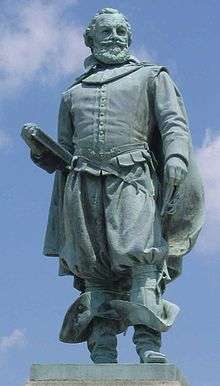
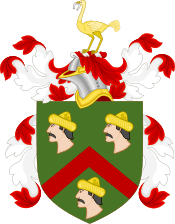
In 1606, Smith became involved with the Virginia Company of London's plan to colonize Virginia for profit; it had been granted a charter by King James. The expedition set sail in three small ships, the Discovery, the Susan Constant, and the Godspeed, on 20 December 1606. His page was a 12-year-old boy named Samuel Collier.[1]
During the voyage, Smith was charged with mutiny, and Captain Christopher Newport (in charge of the three ships) had planned to execute him. These events happened approximately when the expedition stopped in the Canary Islands[9][10] for resupply of water and provisions. Smith was under arrest for most of the trip. However, upon first landing at what is now Cape Henry on 26 April 1607, unsealed orders from the Virginia Company designated Smith as one of the leaders of the new colony, thus, perhaps, sparing Smith from the gallows.[1][11]
By the summer of 1607, the English colonists were still living in temporary housing. The search for a suitable site ended on 14 May 1607 when Captain Edward Maria Wingfield, president of the council, chose the Jamestown site as the location for the colony. After the four-month ocean trip, their food stores were sufficient only for each to have a cup or two of grain-meal per day. Due to swampy conditions and widespread disease, someone died almost every day. By September, more than 60 of the 104 brought by Newport were dead. The men may well have died from drinking brackish creek water and from poor nutrition.[12]
In early January 1608, nearly 100 new settlers arrived with Captain Newport on the First Supply, and through carelessness the village was set on fire. That winter the James River froze over, and the settlers were forced to live in the burnt ruins. During this time, they wasted much of the three months that Newport and his crew were in port loading their ships with iron pyrite (fool's gold). Food supplies ran low, although the Native Americans brought some food, and Smith wrote that "more than half of us died".[13] Later in 1608, Smith spent that summer exploring Chesapeake Bay waterways and produced a map that was of great value to Virginia explorers for more than a century.[13]
In October 1608, Newport brought a second shipment of supplies along with 70 new settlers, including the first women. Some German, Polish, and Slovak craftsmen also arrived,[14][15][16][17] but they brought no food supplies. Newport brought with him a list of counterfeit Virginia Company orders which angered John Smith greatly. He wrote an angry letter in response. One of the orders was to crown the Native American leader Powhatan emperor and give him a fancy bedstead. The Company wanted Smith to pay for Newport's voyage with such as the colony could produce in the form of pitch, tar, sawed boards, soap ashes, and glass.[12]
After that, Smith tried to obtain food from the local Native Americans and it took threats of military force for them to comply. Powhatan was alarmed at the great number of white men coming and may have been trying to starve them out.[12]
Smith found that there were those among both the settlers and Native Americans who were planning to take his life, and it is written that he was warned about the plan by Pocahontas. He called a meeting and threatened those who were spoiled and not working "that he that will not work shall not eat." After that, the situation improved and the settlers worked with more industry, albeit with some punishments as needed.[18][19]
Encounter with Pocahontas' tribe
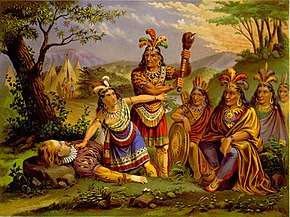

In December 1607, while seeking food along the Chickahominy River, Smith was captured and taken to meet the chief of the Powhatans at Werowocomoco, the main village of the Powhatan Confederacy. The village was on the north shore of the York River about 15 miles due north of Jamestown and 25 miles downstream from where the river forms from the Pamunkey River and the Mattaponi River at West Point, Virginia. Smith feared for his life, but he was eventually released without harm and later attributed this in part to the chief's daughter Pocahontas who, according to Smith, threw herself across his body:[20] "at the minute of my execution, she hazarded the beating out of her own brains to save mine; and not only that, but so prevailed with her father, that I was safely conducted to Jamestown".[21]
In 1860, Boston businessman and historian Charles Deane was the first scholar to question specific details of Smith's writings. Smith's version of events is the only source and skepticism has increasingly been expressed about its veracity. One reason for such doubt is that, despite having published two earlier books about Virginia, Smith's earliest-surviving account of his rescue by Pocahontas dates from 1616, nearly 10 years later, in a letter entreating Queen Anne to treat Pocahontas with dignity.[21] The time gap in publishing his story raises the possibility that Smith may have exaggerated or invented the event to enhance Pocahontas' image. However, in a recent book, professor Leo Lemay of the University of Delaware points out that Smith's earlier writing was primarily geographical and ethnographic in nature and did not dwell on his personal experiences; hence, there was no reason for him to write down the story until this point.[22]
Henry Brooks Adams, the pre-eminent Harvard historian of the second half of the 19th century, attempted to debunk Smith's claims of heroism. He said that Smith's recounting of the story of Pocahontas had been progressively embellished, made up of "falsehoods of an effrontery seldom equaled in modern times". There is consensus among historians that Smith tended to exaggerate, but his account does seem to be consistent with the basic facts of his life. Adams' attack on Smith, an attempt to deface one of the icons of Southern history, was likely motivated by political considerations in the wake of the American Civil War. Adams had been influenced to write his fusillade against Smith by John G. Palfrey who was promoting New England colonization as the founding of America, as opposed to southern settlement. The accuracy of Smith's accounts has continued to be a subject of debate over the centuries.[23]
Some have suggested that Smith believed that he had been rescued, when he had in fact been involved in a ritual intended to symbolize his death and rebirth as a member of the tribe.[24][25] In Love and Hate in Jamestown, David A. Price notes that this is only guesswork, since little is known of Powhatan rituals, and there is no evidence for any similar rituals among other Native American tribes in North America.[26]
In True Travels (1630), Smith told a similar story of having been rescued by the intervention of a young girl after being captured in 1602 by Turks in Hungary. Karen Kupperman suggests that he "presented those remembered events from decades earlier" when telling the story of Pocahontas.[27] Whatever really happened, the encounter initiated a friendly relationship between the natives and Smith and the colonists at Jamestown. As the colonists expanded further, some of the tribes felt that their lands were threatened, and conflicts arose again.
In 1608, Pocahontas is said to have saved Smith a second time. Smith and some other colonists were invited to Werowocomoco by Chief Powhatan on friendly terms, but Pocahontas came to the hut where the English were staying and warned them that Powhatan was planning to kill them. Due to this warning, the English stayed on their guard and the attack never came.[28] Also in 1608, Polish craftsmen were brought to the colony to help it develop. Smith wrote that two Poles rescued him when he was attacked by a Native American.[29]
Smith's explorations of the Chesapeake Bay
In the summer of 1608, Smith left Jamestown to explore the Chesapeake Bay region and search for badly needed food, covering an estimated 3,000 miles. These explorations have been commemorated in the Captain John Smith Chesapeake National Historic Trail, established in 2006. In his absence, Smith left his friend Matthew Scrivener as governor in his place, a young gentleman adventurer from Sibton, Suffolk, who was related by marriage to the Wingfield family. (Scrivener later drowned along with Bartholomew Gosnold's brother in an ill-fated voyage to Hog Island during a storm.) Scrivener was not capable of leading the people. Smith was elected president of the local council in September 1608 and instituted a policy of discipline.[18]
Influx of settlers
By that time, some settlers wanted Smith to abandon Jamestown, but he refused. Some deserted to the Native American villages, but Powhatan's people also went by Smith's law of "he who works not, eats not". This was in effect "till they were near starved indeed" and they returned home.[1]
In the spring of 1609, all was well at Jamestown with many dwellings built, acres of land cleared, and much other work done. Then in April, an infestation of rats was discovered, along with dampness, which destroyed all their stored corn. They needed food badly and Smith sent a large group of settlers to fish and others to gather shellfish downriver. They came back without food and were willing enough to take the meager rations offered them. This angered Smith and he ordered them to trade their guns and tools for fruit from the Native Americans and ordered everyone to work or be banished from the fort.[19]
The weeks-long emergency was relieved by the arrival of an unexpected ship, captained by Samuel Argall. He had items of food and wine which Smith bought on credit. Argall also brought news that the (South) Virginia Company of London was being reorganized and was sending more supplies and settlers to Jamestown along with a new governor, Lord De la Warr.[19]
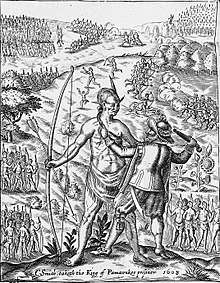
In a May 1609 voyage to Virginia, Virginia Company treasurer Sir Thomas Smith arranged for about 500 colonists to come along, including women and children. A fleet of nine ships set sail. One sank in a storm soon after leaving the harbour, and the Sea Venture with flotilla admiral Sir George Somers aboard wrecked on the Bermuda Islands. They finally made their way to Jamestown one year later in May 1610, after building the Deliverance and Patience to take most of the passengers and crew of the Sea Venture off Bermuda, with the new governor Thomas Gates on board.[30]
In August 1609, John Smith was quite surprised to see more than 300 new settlers arrive, which did not go well for him. London was sending new settlers with no real planning or logistical support.[1] Then in May 1610, Somers and Gates finally arrived with 150 people from the Sea Venture. (Bermuda, or the 'Somers Isles', had remained settled since 1609, and the Virginia Company's possession was made official in 1612 when it was added to Virginia's territory.) Gates soon found that there was not enough food to support all in the colony and decided to abandon Jamestown. As their boats were leaving the Jamestown area, they met a ship carrying the new governor, Lord De la Warr, who ordered them back to Jamestown.[1] Somers returned to Bermuda with the Patience to gather more food for Jamestown but died there. The Patience, captained by his nephew, then sailed for England instead of Virginia.
After spending two-and-a-half years trying to do his best for Jamestown, John Smith was severely injured by an accidental gunpowder explosion in his canoe, which decided his fate for him. He sailed to England for treatment in mid-October 1609. He never returned to Virginia.[1]
Colonists continued to die from various illnesses and disease, with an estimated 150 of the 500 surviving that winter. The Virginia Company, however, continued to finance and transport settlers to sustain Jamestown. For the next five years, Governors Gates and Sir Thomas Dale continued to keep strict discipline, with Sir Thomas Smith in London attempting to find skilled craftsmen and other settlers to send to Jamestown.[31]
New England
.jpg)
In 1614, Smith returned to the Americas in a voyage to the coasts of Maine and Massachusetts Bay. He named the region "New England".[32] The commercial purpose was to take whales for fins and oil and to seek out mines of gold or copper, but when both of these proved impractical the voyage turned to collecting fish and furs to defray the expense.[33] Most of the crew spent their time fishing, while Smith and eight others took a small boat on a coasting expedition during which he traded trifles for 11,000 beaver skins and 100 each of martins and otters.[34]
Smith, having collected a ship's cargo worth of "Furres, … traine Oile and Cor-fish," returned to England. The expedition's second vessel, under the command of Thomas Hunt, stayed behind and captured a number of Natives as slaves,[34] including Squanto of the Patuxet. Smith was convinced that Hunt's actions were directed at him; by inflaming the local population, Smith said, he could "prevent that intent I had to make a plantation there" keeping the country in "obscuritie" so that Hunt and a few merchants could monopolize it.[34] He had, according to Smith, taken his (Smith's) maps and notes of the area to defeat's Smith's settlement plans.[35] He could not believe that Hunt was driven by greed since there was "little private gaine" to be gotten; Hunt "sold those silly Salvages for Rials of eight."[36]
Based on the expedition, Smith published a map in 1616, which was the first to bear the label "New England", though the native placenames were replaced by the names of English cities at the request of Prince Charles.[37] The settlers of Plymouth Colony adopted the name that Smith gave to that area,[37] and other placenames on the map survived to modern times, such as the Charles River (marked as The River Charles) and Cape Ann (Cape Anna).
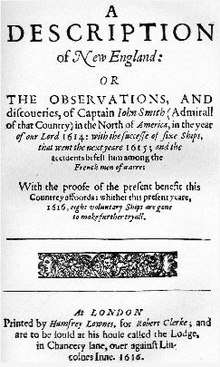
Smith made two attempts in 1614 and 1615 to return to the same coast. On the first trip, a storm dismasted his ship. In the second attempt, he was captured by French pirates off the coast of the Azores. Smith escaped after weeks of captivity and made his way back to England, where he published an account of his two voyages as A Description of New England. He remained in England for the rest of his life.
Comparing his experiences in Virginia with observations of New England, Smith offered a theory of why some English colonial projects had failed. He noted that the French had been able, even in areas nominally under English suzerainty, to essentially monopolize trade in a very short time. Although the peoples inhabiting the coasts from Maine to Cape Cod were numerous and had "large corne fields, and great troupes of well proportioned people," within six weeks the French had obtained everything the Natives had to offer in trade.[38] This was due to the fact that the French had created a great trading network which they could exploit, and the English, who had not cultivated these relations, could not. Where once there was intertribal warfare, the French had created peace in the name of the fur trade. Former enemies like the Massachuset and the Abenaki "are all friends, and have each trade with other, so farre as they have society on each others frontiers."[39]
Smith believed it was too late to reverse this reality even with diplomacy, and that what was needed was military force. He suggested that English adventurers not only rely on his own experience in wars around the world[40] and his experience in New England where his few men could engage in "silly encounters" without injury or long term hostility[41] but also compare the experience of the Spaniards in determining how many armed men were necessary to effect Native compliance.[42]
Death and burial
John Smith died on 21 June 1631 in London. He was buried in 1633 in the south aisle of Saint Sepulchre-without-Newgate Church, Holborn Viaduct, London. The church is the largest parish church in the City of London, dating from 1137. Captain Smith is commemorated in the south wall of the church by a stained glass window.[43][44]
Legacy
John Smith Monument, New Hampshire
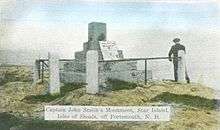
The Captain John Smith Monument currently lies in disrepair off the coast of New Hampshire on Star Island, part of the Isles of Shoals. The original monument was built in 1864 to commemorate the 250th anniversary of John Smith's visit to what he named Smith's Isles. It was a tall pillar set on a triangular base atop a series of steps surrounded by granite supports and a sturdy iron railing. At the top of the original obelisk were three carved faces, representing the severed heads of three Turks that Smith lopped off while in combat during his stint as a soldier in Transylvania.[45]
In 1914, the New Hampshire Society of Colonial Wars partially restored and rededicated the monument for the 300th anniversary celebration of his historic visit.[46] The monument had weathered so badly in the harsh coastal winters that the inscription in the granite had worn away.[47]
Credibility as an author
Many critics judge Captain John Smith's character and credibility as an author based on a single event, his description of Pocahontas saving his life from the hand of Powhatan. Additional and probably more accurate judgments should rest upon his relationship with both the Native Americans and colonists of Jamestown. Smith earned his status as an American hero through his strong work ethic and compromise with the Native Americans, themes that reappear in his writings such as The Generall Historie of Virginia and The True Travels…of Captain John Smith. Most of the critical scepticism of Smith's credibility is a result of the differences between his narratives. His earliest text is A True Relation of Virginia, which was submitted for publication in 1608, the year after his experiences in Jamestown. The second, The Generall Historie, was published sixteen years later in 1624. Compared to The Generall Historie, many events are either left out or changed, including the Pocahontas scene. Accordingly, the publishing of letters, journals, and pamphlets from the colonists was regulated by the companies that sponsored the voyage, in that they must go "directly to the company" because no one was to "write any letter of anything that may discourage others". Smith is now known to have violated this regulation by first publishing A True Relation as an unknown author.[48] Furthermore, the editor of The Generall Historie probably "cut out...references to the Indians' hostility, to bickering among the leaders of Virginia Company, and to the early supposed mutiny of...Smith on the voyage to Virginia."[49]

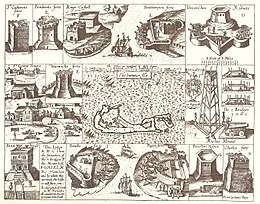
The Pocahontas episode is subject to the most scrutiny by literary critics, for it does not even appear in A True Relation, but does in The Generall Historie. According to Lemay, important evidence to Smith's credibility regarding the story is the fact that "no one in Smith's day ever expressed doubt in [it], and many persons who must have known the truth...including John Rolfe [and] Pocahontas...were in London in 1616 when Smith publicised the story in a letter to the queen".[50]
Smith focuses heavily on Native Americans in all of his works concerning the New World. His relationship with the Powhatan Native Americans is the sole factor that saved the Jamestown colony from sharing the fate of the Roanoke colony.
He was friendly toward them, but never let them forget the might of English weapons… Realizing that the very existence of the colony depended on peace, he never thought of trying to exterminate the natives. Only after his departure were there bitter wars and massacres, the natural results of a more hostile policy. In his writings, Smith reveals the attitudes behind his actions.[51]
In The Generall Historie, Smith implies that the Virginia colonists resented the Native Americans and the two peoples had mostly hostile feelings towards each other. He compares Chief Powhatan to the devil, and refers to the Native Americans as "barbarians".[52] Numerous times, he mentions sending spies to discover the Chief's intent and declining Powhatan's request to relinquish their arms. He also stresses the many experiences where the Native Americans threatened and attempted to kill him.
Lemay contests Smith's depiction of the relations between colonists and Native Americans: "[He] was not only fair, he was surprisingly kind and humanitarian. He treated the native Americans as he treated whites…tortured [none], executed none, and saved native Americans when others wanted to slay them."[53] Smith's own past as a commoner allowed him to sympathize with the Native Americans, and he believed that they were not inferior to the whites but just "at a different stage of civilisation".[54] The respect between Smith and the Powhatan earned him the title of a werowance, "a chieftain among the whites".[53] The relationship between Smith and Chief Powhatan is further evidence of the understanding between these two cultures.
In The Generall Historie, Smith addresses a number of letters exchanged between him and Powhatan which reflect the respect that existed between them. "Half a dozen years after Smith had left Virginia – and after the whites had repeatedly assured Powhatan that Smith was dead – [the] leader instructed his advisor… [and] Pocahontas to look for Smith in England."[55] Judging from these instructions, the Chief seems to have been deeply affected by Smith's rumoured death. This is another indication of the positive relationship held between colonists and Native Americans; if their associations were as Smith depicted them in The Generall Historie, Powhatan would not have been much concerned about his absence or death.
Concerning his relationship with the colonists, Smith is considered by historical and literary critics to be an arrogant braggart. On numerous accounts, he outwardly expressed the opinion that the colonists were worthless; most of them were gentlemen who felt no need to do physical labour. As a method of survival, Smith blatantly rejected the social order that existed in England, which obviously angered the gentlemen of the colony. Smith was regularly frustrated with the amount of delegation that the colonists went through before a decision could be made. Smith's disgust with the "gentlemen" of Jamestown was clear; he makes several references to them as "useless parasites," for their ignorance in the laborious tasks that are required for beginning a colony.[56] His frustration with them did not end at their inability to work, but also extended to the social order that they believed they were entitled to. The colonists, accustomed to the social order of England, rejected the social construct that Smith created in Jamestown. They perceived Smith's establishment of this new structure as a challenge to their "deserved" respect.
Smith mentions several times in his writings that having actual workers would have been better than what the Virginia Company sent over: "twentie good workmen had been better than all them all".[57] In Smith's hopes to better colonize the Americas, he urges the Massachusetts Bay Company not to make the same mistake that the Virginia Company made: "nor such multitude of Officers, neither masters, gentlemen, gentlewomen and children as you have men to work, which idle charges you will find very troublesome, and the effects dangerous, and one hundred good labourers better than a thousand such Gallants as we were sent me that could do nothing."[57]
In reality, Smith was discontent with only a few colonists who acted this way; he "claimed the early colonists were heroes. His primary purpose in writing The Generall Historie...was to eternalise 'the memory of those that effected' the settlement of Virginia".[58] Smith goes so far as to compare the colonists to Adam and Eve in A Description of New England (1616). Just as Adam and Eve spread productivity throughout the world, so the colonists created life in the Virginia colony. Smith essentially sympathized with gentlemen; he knew that it was not their fault that they were useless and that this trait was merely a product of the imposed standards of English society. He recognized that "they were imprisoned by their own self-imposed limitations. What they could and could not do was decided by their awareness of traditional roles and by the shame that they would feel if others saw them engaged in physical work".[59] Lemay suggests that, as a result of Smith's strict rules and the emigration to America, these men could shed these roles and create new lives for themselves in which they could celebrate the products of their labours and not feel humiliated.
Promoter of American colonization
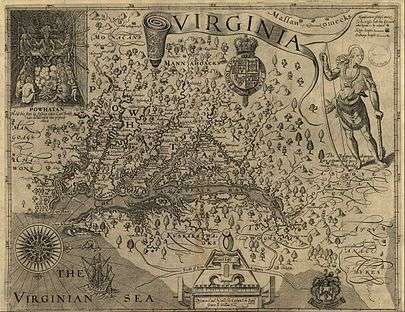
One of John Smith's main incentives in writing about his New World experiences and observances was to promote the colonization of the New World by England. Many promotional writers sugar-coated their depictions of America in order to heighten its appeal, but Smith was not one to exaggerate the facts. He was very straightforward with his readers about both the dangers and the possibilities of colonization. Instead of proclaiming that there was an abundance of gold in the New World, as many writers did, Smith illustrated that what was truly abundant within America was monetary opportunity in the form of industry.[60] Smith was realistic about his proposition for colonization and the benefits that it could yield. He recognized that no "other motive [besides] wealth…would draw [potential colonists] from their ease and humours at home".[61] "Therefore, he presented in his writings actual industries that could yield significant capital within the New World: fishing, farming, shipbuilding, and fur trading".<[62]
In A Description of New England, Smith illustrates America as an ideal environment for such trades and enumerates the monetary benefits that they would bring, rather than making false promises of abounding gold to his readers. Smith attempted to attract interest for colonization by depicting the opportunities that fertile soil and abundant resources would bring. He insists, however, that only hard workers will be able to reap such benefits. Just as Smith did not exaggerate the possibilities for wealth within America, he did not understate the dangers and toil associated with colonization. He declared that only those with a strong work ethic would be able to "live and succeed in America" in the face of such dangers.[63] Colonists would have to risk their lives in order to benefit from the "phenomenal possibilities" that the New World offered.[60] As a promoter of American colonization, Smith did not placate his readers. He wanted potential colonists to be aware of the dangers that they faced, the work that colonization would require, and the benefits that they stood to gain.
Additional works
A Map of Virginia is focused centrally on the observations that Smith made about the Native Americans, particularly regarding their religion and government. This specific focus would have been Smith's way of adapting to the New World by assimilating the best parts of their culture and incorporating them into the colony. A Map of Virginia was not just a pamphlet discussing the observations that Smith made, but also a map which Smith had drawn himself, to help make the Americas seem more domestic. As Lemay remarks, "maps tamed the unknown, reduced it to civilisation and harnessed it for Western consciousness," promoting Smith's central theme of encouraging the settlement of America.[64] Many "naysayers of the late nineteenth and early twentieth century" have made the argument that Smith's maps were not reliable because he "lacked a formal education in cartography".[65] That allegation, however, was proved false by the fact that Smith was a "master in his chosen fields of experience".[65]
The Proceedings of the English Colony In Virginia was a compilation of other writings; it narrates the colony's history from December 1609 to the summer of 1610, and Smith left the colony in October 1609 due to a gunpowder accident. The writing style of The Proceedings is thought to be better constructed than A Map of Virginia.[66]
Publications
John Smith published eight volumes during his life. The following lists the first edition of each volume and the pages on which it is reprinted in Arber 1910:
1. A true relation of such occurrences and accidents of noate as hath hapned in Virginia since the first planting of that collony, which is now resident in the south part thereof, till the last returne from thence. London: Printed for Iohn Tappe, and are to bee solde at the Greyhound in Paules-Church-yard, by W.W. 1608.
Quarto. Arber 1910, pp. I:1–40. First attributed to "a Gentleman of the said Collony." then to "Th. Watson" and finally (in 1615) to Smith.[67] A digitized version is hosted at Project Jamestown. Another was prepared for the etext library of the University of Virginia.
2. A map of Virginia: VVith a description of the countrey, the commodities, people, government and religion. VVritten by Captaine Smith, sometimes governour of the countrey. Whereunto is annexed the proceedings of those colonies, since their first departure from England, with the discourses, orations, and relations of the salvages, and the accidents that befell them in all their iournies and discoveries. Taken faithfully as they were written out of the writings of Doctor Russell. Tho. Studley. Anas Todkill. Ieffra Abot. Richard Wiefin. Will. Phettiplace. Nathaniel Povvell. Richard Pots. And the relations of divers other diligent observers there present then, and now many of them in England. Oxford: Printed by Joseph Barnes. 1612.
Quarto. Arber 1910, pp. I:41–174 Edited by W[illiam] S[immonds]. An abridged edition was printed in Purchas 1625, pp. IV:1691–1704.
3. A description of New England: or The obseruations, and discoueries, of Captain Iohn Smith (admirall of that country) in the north of America, in the year of our Lord 1614: with the successe of sixe ships, that went the next yeare 1615; and the accidents befell him among the French men of warre: with the proofe of the present benefit this countrey affoords: whither this present yeare, 1616, eight voluntary ships are gone to make further tryall. London: Printed by Humfrey Lownes, for Robert Clerke. 1616.
Quarto. Arber 1910, pp. I:175–232 This volume was translated into German and published in Frankfurt in 1617.[67] A digitized copy is hosted by the Digital Commons of the University of Nebraska–Lincoln.
4. Nevv Englands trials: Declaring the successe of 26. ships employed thither within these sixe yeares: with the benefit of that countrey by sea and land: and how to build threescore sayle of good ships, to make a little navie royall. London: Printed by VVilliam Iones. 1620.
Quarto. Arber 1910, pp. I:233–248. This volume contained some of the material from A Description of New-England. A new and somewhat expanded "second edition" was printed in 1622 also by William Jones.[68] Arber 1910, pp. I:249–72
5. The Generall Historie of Virginia, New England, and the Summer isles: with the names of the Adventurers, Planters, and Governours from their first beginning, Ano: 1584, to this present 1624. With the Proceedings of those Severall Colonies and the Accidents that befell them in all their Journyes and Discoveries. Also the Maps and Descriptions of all those Countryes, their Commodities, people, Government, Customes, and Religion yet knowne. Divided into sixe Bookes. London: Printed by I.D. and I.H. for Michael Sparkes. 1624.
Folio. Arber 1910, pp. I:273–38; II:385–784. The work was republished in 1726, 1727 and 1732.[69]
6. An accidence or The path-way to experience: Necessary for all young sea-men, or those that are desirous to goe to sea, briefly shewing the phrases, offices, and words of command, belonging to the building, ridging, and sayling, a man of warre; and how to manage a fight at sea. Together with the charge and duty of every officer, and their shares: also the names, vveight, charge, shot, and powder, of all sorts of great ordnance. With the vse of the petty tally. London: Printed [by Nicholas Okes] for Ionas Man, and Benjamin Fisher. 1626.
Octavo. Arber 1910, pp. II:785–804. In the following year the work was enlarged probably by another hand[70] as A sea grammar: vvith the plaine exposition of Smiths Accidence for young sea-men, enlarged. Diuided into fifteene chapters: what they are you may partly conceiue by the contents. London: Printed by Iohn Hauiland. 1627. . That same year another printing of An Accidence was also made for Jonas Man and Benjamin Fisher. In 1653 this work, under the title A Sea Grammar, was entirely recast and substantially enlarged by "B.F."[71]
7. The true travels, adventures, and observations of Captaine Iohn Smith, in Europe, Asia, Affrica, and America from Anno Domini 1593 to 1629: his accidents and sea-fights in the Straights: his service and strategems of warre in Hungaria, Transilvania, Wallachia, and Moldavia, against the Turks, and Tartars: his three single combats betwixt the Christian Armie and the Turks : after how he taken prisoner by the Turks, sold for a slave, sent into Tartarias: his description of the Tartars, their strange manners and customes of religions, diets, buildings, warres, feasts, ceremonies, and living: how hee flew the Bashaw of Nalbrits in Cambia, and escaped from the Turkes and Tatars: together with a continuation of his Generall history of Virginia, Summer-Iles, New England, and their proceedings, since 1624 to this present 1629: as also of the new plantations of the great river of the Amazons, the iles of St. Christopher, Mevis, and Barbados in the West Indies / all written by actuall authors, whose names you shall finde along the history. London: Printed by J.H. for Thomas Slater. 1630.
Folio. Arber 1910, pp. II:805–916. Five years before the publication a shorter version of this autobiography was published in Purchas 1625, pp. II:1361–70 in a chapter entitled "The Trauels and Aduentures of Captaine IOHN SMITH in diuers parts of the world, begun about the yeere 1596."
8. Advertisements for the unexperienced planters of New-England, or any where, or, The path-way to experience to erect a plantation: with the yearely proceedings of this country in fishing and planting, since the yeare 1614. to the yeare 1630. and their present estate: also how to prevent the greatest inconveniences, by their proceedings in Virginia, and other plantations, by approved examples : with the countries armes, a description of the coast, harbours, habitations, land-markes, latitude and longitude: with the map, allowed by our royall King Charles. London: Printed by I. Havilland. 1631.
Quarto. Arber 1910, pp. II:917–66.
In popular culture
John Smith was honored on two of the three stamps of the Jamestown Exposition Issue held 26 April – 1 December 1907 at Norfolk, Virginia to commemorate the founding of the Jamestown settlement. The 1-cent John Smith, inspired by the Simon de Passe engraving of the explorer was used for the 1-cent postcard rate. The 2-cent Founding of Jamestown stamp paid the first-class domestic rate.[72]
1907 issue |
1907 issue |
- Captain Smith was portrayed by Anthony Dexter in the 1953 independent low-budget film Captain John Smith and Pocahontas.
- A fictionalized version of John Smith appears in James A. Michener's 1978 novel Chesapeake.
- John Smith is one of the main characters in Disney's 1995 animated film Pocahontas and its 1998 straight-to-video sequel Pocahontas II: Journey to a New World. He is voiced by Mel Gibson in the first movie and by his younger brother Donal Gibson in the sequel.
- Smith and Pocahontas are also central characters in the Terrence Malick film The New World, in which he was portrayed by Colin Farrell.
- Country singer Blake Shelton played the Disney version in an unaired "Cut for Time" sketch on Saturday Night Live.
See also
References
- 1 2 3 4 5 6 7 Snell 1974, Ch. 4
- ↑ David Cressy (1987). "Coming Over: Migration and Communication Between England and New England in the Seventeenth Century". p. 99. Cambridge University Press,
- ↑ Lefroy, John Henry (1882), The Historye of the Bermudaes Or Summer Islands, Hakluyt Society, p. iv, retrieved 21 September 2008
- ↑ Churton, Ralph, The lives of William Smyth, Bishop of Lincoln, and Sir Richard Sutton (1800), p. 5
- ↑ "History of the School". King Edward VI Grammar School, Louth. Archived from the original on 7 January 2009. Retrieved 21 June 2008.
- ↑ Peter Firstbrook (2014). "4 Knight-Errant (1602)". A Man Most Driven: Captain John Smith, Pocahontas and the Founding of America. Oneworld Publications.
- ↑ Michel., Leo, (2013). Bŭlgarii︠a︡ i neĭnii︠a︡t narod pod osmanska vlast : prez pogleda na anglosaksonskite pŭteshestvenit︠s︡i, 1586-1878 : otkrivaneto na edna narodnost. Glukharova, Marieta. Sofia︡, Bulgaria: Tangra TanNakRa. p. 23. ISBN 9789543781065. OCLC 894636829.
- ↑ "Soldier of Fortune: John Smith before Jamestown". neh.gov. Retrieved 20 September 2015.
- ↑ John Smith: English Explorer and Colonist
- ↑ John Smith: A Foothold in the New World
- ↑ A True Relation of Such Occurrences and Accidents of Note as Happened in Virginia (1608), EText, University of Virginia
- 1 2 3 Snell 1974, p. 84, Ch. 4
- 1 2 Snell 1974, p. 83, Ch. 4
- ↑ Congressional Record (5 July 1956). "Congressional Record – 1956". Congressional Record. pp. 11905–11906. Retrieved 1 October 2014.
- ↑ Congressional Record (1975). "Congressional Record 1975". Congressional Record. Retrieved 1 October 2014.
- ↑ Congressional Record (1976). "Congressional Record 1976". Congressional Record. Retrieved 1 October 2014.
- ↑ Eisenhower, Dwight D. (28 September 1958). "Jamestown Pioneers From Poland". White House. Retrieved 1 October 2014.
- 1 2 "To Conquer is to Live". google.com. Retrieved 20 September 2015.
- 1 2 3 Snell 1974, p. 85, Ch. 4
- ↑ Smith, Generall Historie
- 1 2 Johnson, Caleb. "John Smith's Letter to Queen Anne regarding Pocahontas". Mayflower Web Pages. Archived from the original on June 16, 2006. Retrieved 13 March 2018.
- ↑ Lemay, J. A. Leo. Did Pocahontas Save Captain John Smith? Athens, Georgia: The University of Georgia Press, 1992, p. 25. Lemay's other arguments in favour of Smith are summarized in Birchfield, 'Did Pocahontas' Archived 26 June 2012 at the Wayback Machine..
- ↑ Lepore, Jill, "The New Yorker", 2 April 2007, pp. 40–45
- ↑ Gleach, Powhatan's World, pp. 118–21.; Kupperman, Indians and English, pp. 114, 174.
- ↑ Horwitz, Tony. A Voyage Long and Strange: Rediscovering the New World. Henry Holt and Co. p. 336. ISBN 0-8050-7603-4.
- ↑ pp. 243–44
- ↑ Karen Ordahl Kupperman, The Jamestown Project, Cambridge: Harvard University Press, 2007, 51–60, 125–6
- ↑ Symonds, Proceedings, pp. 251–2; Smith, Generall Historie, pp. 198–9, 259.
- ↑ James Pula. "Jamestown's 400th Anniversary."/
- ↑ Snell 1974, p. 91, Ch. 4
- ↑ Snell 1974, pp. 93–94, Ch. 4
- ↑ New England. (2006). In Encyclopædia Britannica. Retrieved 20 June 2006, from Encyclopædia Britannica Premium Service:
- ↑ Smith 1907, p. II:3–4.
- 1 2 3 Smith 1907, p. II:4.
- ↑ Smith 1616, p. 47 reprinted in Arber 1910, p. I:219.
- ↑ Smith 1907, pp. II:4–5.
- 1 2 "The lie that charted New England's future". BostonGlobe.com. Retrieved 20 September 2015.
- ↑ Smith 1616, p. 26 reprinted in Arber 1910, p. I:205.
- ↑ Smith 1616, p. 28 reprinted in Arber 1910, p. I:206.
- ↑ Smith 1631, p. 1 reprinted in Arber 1910, p. II:925.
- ↑ Smith 1620 reprinted in Arber 1910, p. I:264.
- ↑ Smith 1631, pp. 30–31 reprinted in Arber 1910, pp. II:955–56.
- ↑ "Saint Sepulchre-without-Newgate Church". st-sepulchre.org.uk. Archived from the original on 8 August 2002. Retrieved 20 September 2015.
- ↑ "John Smith (1580–1631) – Find A Grave Memorial". findagrave.com. Retrieved 20 September 2015.
- ↑ J. Dennis Robinson The Ugliest Monument in New England
- ↑ Robinson. John Smith Memorial Photo History
- ↑ "John Smith Memorial Photo History". Archived from the original on 4 May 2014. Retrieved 2 May 2014.
- ↑ Lemay 1991, p. 40.
- ↑ Lemay 1991, p. 41.
- ↑ Lemay 1991, p. 51.
- ↑ Randel, William. "Captain John Smith's Attitudes toward the Indians". The Virginia Magazine of History and Biography (1939): 218–229. p. 219
- ↑ Smith, John. "The Generall Historie of Virginia, New-England, and the Summer Isles". The Heath Anthology of American Literature. Ed. Paul Lauter. 6th Edition. Boston: Houghton Mifflin Harcourt Publishing Company, 2009 [1624]. 276–281. p.277
- 1 2 Lemay 1991, p. 116.
- ↑ Lemay 1991, p. 224.
- ↑ Lemay 1991, p. 146.
- ↑ Lemay 1991, p. 170.
- 1 2 Lemay 1991, p. 173.
- ↑ Lemay 1991, p. 26.
- ↑ Lemay 1991, p. 27.
- 1 2 Lemay 1991, p. 80.
- ↑ Smith, John. "A Description of New England". The Heath Anthology of American Literature. Ed. Paul Lauter. 6th Edition. Boston: Houghton Mifflin Harcourt Publishing Company, 2009 [1616]. p. 282
- ↑ Lemay 1991, p. 91.
- ↑ Lemay 1991, p. 81.
- ↑ Lemay 1991, p. 42.
- 1 2 Lemay 1991, p. 43.
- ↑ Lemay 1991, p. 48.
- 1 2 Seccombe 1910, p. xxvii.
- ↑ Seccombe 1910, p. xvii.
- ↑ & Seccombe 191, p. xxvii.
- ↑ Seccombe 1910, p. xxviii.
- ↑ Arber 1910, p. I:cxxxi.
- ↑ "Jamestown Exposition Issue", Arago: people, postage & the post online, National Postal Museum, viewed 17 April 2014.
Sources
- Arber, Edward, ed. (1910). Travels and Works of Captain John Smith. Edinburgh: John Grant. Hosted online by the Internet Archive: Volume I and Volume II.
- Lemay, J. A. Leo (1991). The American Dream of Captain John Smith. Charlottesville: University Press of Virginia.
- Purchas, Samuel, ed. (1625). Hakluytus posthumus, or, Purchas his Pilgrimes. Contayning a history of the world, in sea voyages, & lande-travells, by Englishmen and others …. London: Imprinted for H. Fetherston. The original imprint was "In fower parts, each containing five bookes." All four volumes are hosted online by the Library of Congress
- Seccombe, Thomas (1910). "Bibliography". In Arber, Edward. Travels and Works of Captain John Smith. Edinburgh: John Grant. pp. I:xxvii–xxx.
- Smith, John (1616). A description of New England: or The observations, and discoveries, of Captain John Smith (admirall of that country) in the north of America, in the year of our Lord 1614. London: Printed by Humfrey Lownes, for Robert Clerke. This book is reprinted in Arber 1910, pp. 175–232. A digitized version can be downloaded from The Digital Commons at University of Nebraska–Lincoln.
- Smith, John (1620). New Englands trials. London: Printed by William Jones.
- Smith, John (1624). The generall historie of Virginia, New England & the Summer Isles. London: Printed by I.D. and I.H. for Michael Sparkes. . Macmillan published a verbatim version of the first printing (with different pagination) of this work as well as Smith's 1630 autobiography and his Sea Grammar: Smith, John (1907). The generall historie of Virginia, New England & the Summer Isles: together with The true travels, adventures and observations, and A sea grammar. New York: Macmillan. The Macmillan version, is hosted by the Library of Congress (in two volumes): Volume I and Volume II. A searchable version (with various download options) of the same book is hosted by the Internet Archive: Voume I and Volume II. The Generall History of Virginia is also contained in Arber 1910, pp. I:273–38; II:385–784. The work was twice republished in Smith's life (in 1726 and 1727) and immediately after his death (in 1732).
- Smith, John (1631). Advertisement for the unexperienced Planters of New-England, or any where. London: John Haviland.
- Snell, Tee Loftin (1974). The wild shores: America's beginnings. Washington DC: National Geographic Society (U.S.), Special Publications Division.
Further reading
- Woolley, Benjamin. Savage Kingdom, The True Story of Jamestown, 1607, and the Settlement of America, First Harper Perennial Edition Published 2008
- Horn, James, ed. Captain John Smith, Writings, with Other Narratives of Roanoke, Jamestown, and the English Settlement of America (Library of America, 2007) ISBN 978-1-59853-001-8.
- Philip L. Barbour, The Jamestown Voyages under the First Charter, 1606–1609, 2 vols., Publications of the Hakluyt Society, ser.2, 136–37 (Cambridge: Cambridge University Press, 1969)
- A. Bryant Nichols Jr., Captain Christopher Newport: Admiral of Virginia, Sea Venture, 2007
- Philip L. Barbour, The Three Worlds of Captain John Smith (Boston: Houghton Mifflin, 1964)
- Gleach, Frederic W. Powhatan's World and Colonial Virginia. Lincoln: University of Nebraska Press, 1997.
- Dorothy Hoobler and Thomas Hoobler, Captain John Smith: Jamestown and the Birth of the American Dream (Hoboken, N.J.: John Wiley & Sons, 2006)
- Horn, James. A Land as God Made It: Jamestown and the Birth of America (New York: Basic Books, 2005)
- Jenks, Tudor. Captain John Smith (New York: Century Co., 1904)
- Kupperman, Karen Ordahl ed., John Smith: A Select Edition of His Writings (Chapel Hill: University of North Carolina Press, 1988)
- Price, David A., Love and Hate in Jamestown: John Smith, Pocahontas, and the Heart of a New Nation (New York: Knopf, 2003)
- Giles Milton, Big Chief Elizabeth: The Adventures and Fate of the First English Colonists in America, Macmillan, New York, 2001
- Smith, John The Complete Works of Captain John Smith (1580–1631) in Three Volumes, edited by Philip L. Barbour, 3 vols. (Chapel Hill: University of North Carolina Press for The Institute of Early American History and Culture, Williamsburg, 1986)
- Smith, John. The Generall Historie of Virginia, New-England, and the Summer Isles. 1624. Repr. in Jamestown Narratives, ed. Edward Wright Haile. Champlain, VA: Roundhouse, 1998. pp. 198–9, 259.
- Smith, John. Letter to Queen Anne. 1616. Repr. as 'John Smith's Letter to Queen Anne regarding Pocahontas'. Caleb Johnson's Mayflower Web Pages. 1997. Accessed 23 April 2006.
- Symonds, William. The Proceedings of the English Colonie in Virginia. 1612. Repr. in The Complete Works of Captain John Smith. Ed. Philip L. Barbour. Chapel Hill: University of North Carolina Press, 1986. Vol. 1, pp. 251–2
- Warner, Charles Dudley, Captain John Smith, 1881. Repr. in Captain John Smith Project Gutenberg Text, accessed 4 July 2006
- Striker, Laura Polanyi and Bradford Smith. "The Rehabilitation of John Smith". The Journal of Southern History, Vol. 28, 4 Nov. (Nov. 1962) pp. 474–481.
External links
| Wikiquote has quotations related to: John Smith (explorer) |
| Wikimedia Commons has media related to Captain John Smith. |
| Wikisource has the text of an 1879 American Cyclopædia article about John Smith (explorer). |
- Captain John Smith Chesapeake National Historic Trail Official Website
- NGS Then and Now – John Smith
- John Smith Water Trail Blog
- The Captain John Smith Water Trail
- A Description of New England (1616) online text (PDF)
- The Ugliest Monument in New England (seacoastnh.com)
- The Ugliest Monument in New England II
- John Smith Memorial Photo History
- Complete text of the Generall Historie American Memory
- Texts of Imagination & Empire, by Emily Rose, Princeton University Folger Shakespeare Library
- Works by or about John Smith at Internet Archive
- Works by John Smith at LibriVox (public domain audiobooks)

| Government offices | ||
|---|---|---|
| Preceded by Matthew Scrivener |
Colonial Governor of Virginia 1608–1609 |
Succeeded by George Percy |
